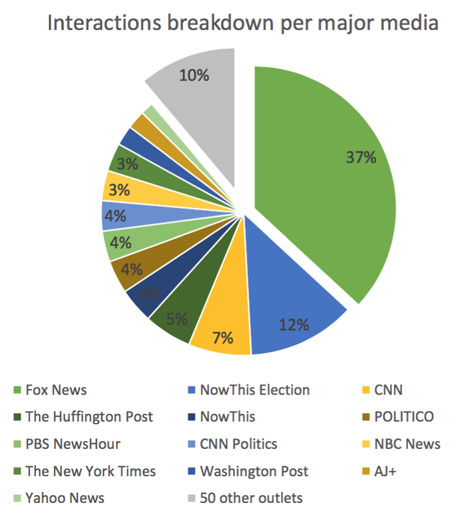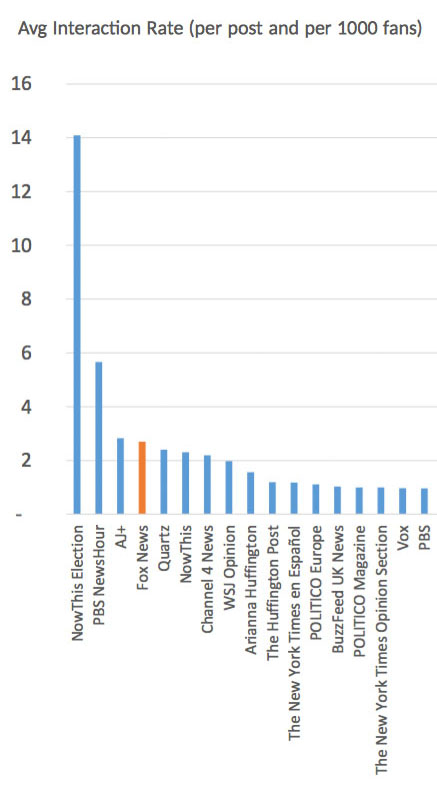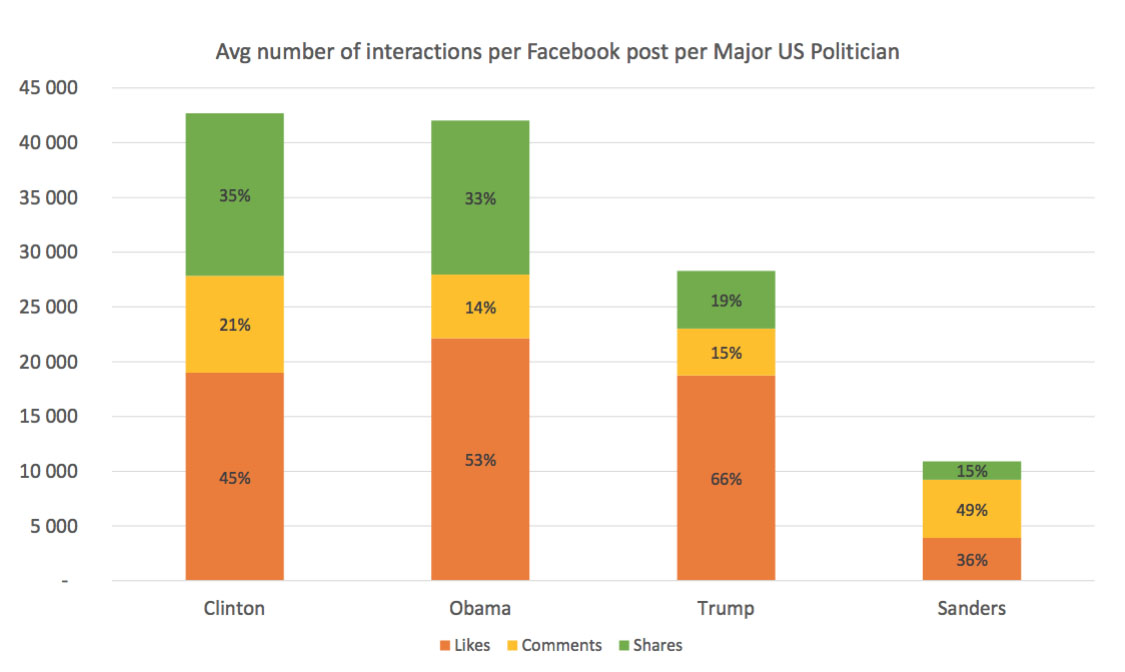Mohamed Belmaaza is a data analyst at FranceTv Info, the French public news offer online, where he spends his time working on issues related to editorial strategies, audience development, conceptual projects and distributed platforms. He is interested in understanding the evolving behaviours of readers online, and the following piece outlines his takeaways from analysing the coverage of the US election on Facebook from more than 60 news outlets.
As Facebook is now a crucial platform for spreading news and shaping political ideals, it is becoming increasingly important to monitor – almost on a daily basis – the way the incessant algorithm changes are impacting the coverage of major news events, such as the upcoming US presidential elections.
Using Facebook data pulled from social media analytics tool CrowdTangle for more than 60 US-based and international news media outlets, it was possible to analyse the way people were interacting (liking, commenting and sharing) with content related to the US presidential election published between 1 June and 15 July.
The first point of focus for the research was to examine the size of the audiences and the number of interactions media outlets were getting, and whether or not there was a balance in the way all sides were given a voice on the social platform.
The data revealed that 10 pages (out of 63) garnered more than 80 per cent of the total interactions, with Fox News (13 million fans) alone generating 35 per cent of total interactions (likes, comments and shares).
NowThis Elections (1.2 million fans) came second with 12 per cent of total interactions, and CNN (22 million fans) third, with seven per cent of total interactions.
No more than 10 per cent of interactions were generated by the bottom 50 news outlets.

It is then interesting to note how the size of the Facebook community – the number of people who liked a certain publisher's page – becomes irrelevant when it comes to generating interactions.
The New York Times, which has almost the same fan base as Fox News, generated nearly 10 times fewer interactions, stressing the wide gap between the reach of Fox News, a conservative news company, and that of the sum of major liberal news companies.
On the other hand, an analysis of the number of posts relating to the US elections campaign showed that Fox News has been posting less content on Facebook compared to other media outlets.
During the period of analysis, Fox News only posted 462 pieces of content, way below Politico (1700 posts), CNN Politics (1300 posts) and the Washington Post (470 posts).
These figure alone underscore the huge reach of Fox News on Facebook, as it manages, with fewer posts and a smaller fan base, to be the most impactful news company on the most important social platform nowadays in terms of global reach and total number of interactions.
For coverage of the US presidential elections, the company is among the top five brands with the most interactions per post per 1000 fans (2,7 per 1000), after AJ+ (2,8 per 1000), PBS Newshour (6 per 1000), and way after NowThis Elections (14 per 1000).

Data from the 63 media pages analysing more than 12,500 pieces of content highlighted the reasons behind these performances, as it showed that a native video is likely to get, on average, 13 times more interactions than an external link.
This gap was even wider when it came to the number of times a native video was shared, which was 20 times higher than that of an external link.
Fox News has completely integrated this algorithm tweak into its strategy, as it favours native videos and native photos over external links that would drive traffic to its website.
During the period of analysis, 85 per cent of the content (videos, articles, images) Fox News posted to Facebook about the US election were native, either video or photo, compared to an average of 19 per cent across the board –15 per cent were external links, compared to an average of 80 per cent for the 63 pages included in the research.
Consequently, 13 of the 20 elections-related posts with the most interactions on Facebook from the 63 news pages ended up being published by Fox News – 13 posts out of which eight were native videos, four native photos, and only one external link.
If reach is an explanation for Fox News' success on Facebook, it remains only part of the story. One should take an in-depth look and perform a deep-dive analysis of the editorial slant of Fox News online to understand the other reason behind its impact.
Data from CrowdTangle showed that Fox News dedicated more than 48 per cent of its coverage to Donald Trump, almost 30 per cent to Hillary Clinton, 18 per cent to Barack Obama, 2 per cent to Bernie Sanders, and the rest to the other candidates.
Its coverage of Trump was mostly neutral (such as "Donald J. Trump released a statement in the wake of the horrific #OrlandoShooting") or indirectly positive, where Fox News brought a pro-Trump interviewee to deliver a statement about the Republican candidate, such as this quote from Judge Jeanine Pirro, or this quote from Speaker Paul Ryan.
On the other hand, the posts dedicated to Clinton or Obama were generally negative. For Clinton, they related mostly to the emails scandal, whereas for Obama, the focus was mainly on his gun control stance, especially in the wake of the Orlando shooting.
Consequently, a post about Obama or Clinton generated almost twice the engagement a post about Trump would get – 40,000 interactions on average for Obama or Clinton, compared to 26,000 interactions for Trump.

An average post about Obama or Clinton also got more shares than one about Trump. Some 35 per cent of the interactions related to a post about Obama or Clinton were shares, compared to 19 per cent for posts about Trump.
Reversely, posts about Trump tended to get more likes than those about Obama or Clinton (66 per cent compared to 50 per cent).
Posts about Sanders, on the other hand, got the higher share of comments as most of the posts related to him were Facebook Lives, which usually generate more comments than shares or likes.
Sharing negative posts tends to be motivated by the desire to show friends on Facebook third-party arguments as proof of how serious the topic of the post is. Subjects which Republican supporters tend to rally against, such as gun control, immigration, LGBT rights, homeland security and Clinton’s email scandal, tended to get more shares.
Liking neutral posts, on the other hand, can underline a tacit acceptance of the subject of the post, as in the case of posts about Trump.
During the 'trending topics' scandal, Mark Zuckerberg released a statement saying that Facebook had no political bias against conservative outlets, claiming that Fox News was the media that got the most interactions on the platform.
We can now see that Fox News is clearly dominating coverage of the US presidential election campaign.
This also proves that Fox News – unlike many other publishers – doesn’t seem to be concerned about publishing native content to Facebook, as it embraces the social network by prioritising ideology perhaps to the detriment of generating more traffic to its website, at a time when others in the industry are desperately struggling to find ways to monetise content online and gain more control over their audiences on social networks.
Free daily newsletter
If you like our news and feature articles, you can sign up to receive our free daily (Mon-Fri) email newsletter (mobile friendly).
Related articles
- Journalists are happy to be disconnecting from platforms, should news organisations be worried?
- Protecting journalists on social media, with Valérie Bélair-Gagnon
- What will your audience want in the future?
- 15 free sources of data on the media industry
- Predictions for journalism 2024: social media platforms and strategies










